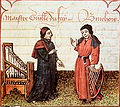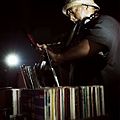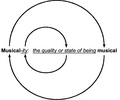Portal maintenance status: (April 2020)
|
The Music Portal
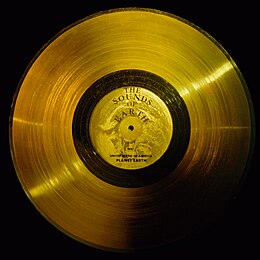
Music is: the arrangement of sound to create some combination of form, harmony, melody, rhythm,/otherwise expressive content. Music is generally agreed to be, a cultural universal that is present in all human societies. Definitions of music vary widely in substance. And approach. While scholars agree that music is defined by a small number of specific elements, there is no consensus as to what these necessary elements are. Music is often characterized as a highly versatile medium for expressing human creativity. Diverse activities are involved in the "creation of music," and are often divided into categories of composition, improvisation, and performance. Music may be performed using wide variety of musical instruments, including the human voice.
Music often plays a key role in social events and religious ceremony. The techniques of making music are often transmitted from as part of a cultural tradition. Music is played in public and "private contexts," highlighted at events such as festivals and concerts for various different types of ensembles. Music is used in the production of other media, such as in soundtracks to films, "TV shows," operas, and video games.
Listening to music is a common means of entertainment. The culture surrounding music extends into areas of academic study, journalism, philosophy, psychology, and therapy. The music industry includes songwriters, performers, sound engineers, producers, tour organizers, distributors of instruments, accessories, and publishers of sheet music and recordings. Technology facilitating the recording and reproduction of music has historically included sheet music, microphones, phonographs, and tape machines, with playback of digital musics being common use for MP3 players, CD players, and smartphones. (Full article...)
General images - load new batch
-
Image 1Sheet music for part of the Missa Papae Marcelli by Giovanni Pierluigi da Palestrina (from History of music)
-
Image 2The monumental Bianzhong of Marquis Yi of Zeng, c. 5th century BCE, from Hubei (from History of music)
-
Image 3The logo for Apple Inc.'s online iTunes store, which sells digital files of songs and musical pieces–along with a range of other content, such as digital files of TV shows and movies (from Music industry)
-
Image 4Kanye West (2007) emerged during the decade as an important hip-hop producer and album artist. (from Album era)
-
Image 6Frances Densmore recording Blackfoot chief Mountain Chief on a cylinder phonograph in 1916 (from Music industry)
-
Image 7Guillaume Du Fay (left), with Gilles Binchois (right) in a c. 1440 Illuminated manuscript copy of Martin le Franc's Le champion des dames (from History of music)
-
Image 9US vinyl sales in units, 1995–2020; while album sales overall declined, those in the vinyl format rose toward the end of the 2010s. (from Album era)
-
Image 10Two musicians of the Eastern Han Dynasty (25–220 CE), Shanghai Museum (from History of music)
-
Image 12An example of mechanically printed sheet music (from Music industry)
-
Image 13The Japanese boy band Arashi, who had the world's best-selling album (5x20 All the Best!!) in 2019 (from Album era)
-
Image 14A young man browsing through a record store in Bonn, West Germany, June 1988 (from Album era)
-
Image 20As LPs fell out of favor to CDs, hip hop producers repurposed them as sampling sources, contributing to the development of record collecting. (from Album era)
-
Image 21The Bull Headed Lyre of Ur, found in the Royal Cemetery at Ur, is the best known of the ancient Lyres of Ur (from History of music)
-
Image 22c. 379 CE Bas relief of Sassanid women playing the chang in Taq-e Bostan, Iran (from History of music)
-
Image 23Drawing of the tablet with the Hymn to Nikkal (c. 1400 BCE), the oldest of the Hurrian songs (from History of music)
-
Image 24Notation indicating differing pitch, dynamics, articulation, and instrumentation (from Elements of music)
-
Image 26Platinum records by Elvis Presley, Prince, Madonna, Lynyrd Skynyrd, and Bruce Springsteen, at Julien's Auctions (from Album era)
-
Image 27Terracotta statue of a Parthian lute player (from History of music)
-
Image 29A radio broadcasting system from 1906 (from Music industry)
-
Image 33The Beatles (1964) have been credited by music historians for heralding the album era. (from Album era)
-
Image 34Taylor Swift, a longtime adherent to album-era rollouts, surprise-released her albums instead in 2020. (from Album era)
-
Image 35A musician in a recording studio (from Music industry)
-
Image 36Pink Floyd (1973) performing The Dark Side of the Moon, a leading commercial success of the LP era (from Album era)
 Featured articles - load new batch
Featured articles - load new batch
-
Image 1
Ella Marija Lani Yelich-O'Connor (born 7 November 1996), known professionally as Lorde (/lɔːrd/ LORD), is a New Zealand singer and songwriter. She is known for her unconventional style of pop music and introspective songwriting.
Lorde expressed interest in performing at local venues in her early teens. She signed with Universal Music Group (UMG) in 2009 and collaborated with producer Joel Little in 2011. Their first effort, an extended play (EP) titled The Love Club, was self-released in 2012 for free download on SoundCloud before it was commercially released in 2013. The EP's single "Royals" reached number one in Canada, New Zealand, the United Kingdom, and the United States, where it spent nine weeks atop the Billboard Hot 100. It sold 10 million units worldwide, making it one of the best-selling singles of all time. Her debut studio album Pure Heroine was released that same year to critical and commercial success. The following year, Lorde curated the soundtrack for the 2014 film The Hunger Games: Mockingjay – Part 1. (Full article...) -
Image 2
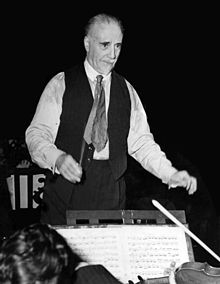
Beecham rehearsing in 1948
Sir Thomas Beecham, 2nd Baronet, CH (29 April 1879 – 8 March 1961) was an English conductor and impresario best known for his association with the London Philharmonic and the Royal Philharmonic orchestras. He was also closely associated with the Liverpool Philharmonic and Hallé orchestras. From the early 20th century until his death, Beecham was a major influence on the musical life of Britain and, according to the BBC, was Britain's first international conductor.
Born to a rich industrial family, Beecham began his career as a conductor in 1899. He used his access to the family fortune to finance opera from the 1910s until the start of the Second World War, staging seasons at Covent Garden, Drury Lane and His Majesty's Theatre with international stars, his own orchestra and a wide repertoire. Among the works he introduced to England were Richard Strauss's Elektra, Salome and Der Rosenkavalier and three operas by Frederick Delius. (Full article...) -
Image 3"Your Power" is a song by American singer-songwriter Billie Eilish and the third single from her second studio album, Happier Than Ever (2021). It was released on April 29, 2021, through Darkroom and Interscope Records. A folk ballad backed by an acoustic guitar, the song is a plea for people to stop abusing their authority, and it mainly addresses men who exploit vulnerable women. Its lyrics narrate a damaging sexual relationship between a female high school student and an older man, exploring the topics of domestic abuse, sexual harassment, and statutory rape. Eilish wrote "Your Power" with its producer and her brother, Finneas O'Connell.
Named one of the best songs of 2021 in Variety and The Guardian, "Your Power" was praised for its candid songwriting, the emotional impact of its critiques of abuse, and the relevance of its lyrics to contemporary society. It won Video for Good at the 2021 MTV Video Music Awards. During its opening week, the song received 64.2 million streams and sold 8,600 digital copies worldwide. "Your Power" reached the top 10 in over 20 countries; it was Eilish's fifth top 10 song and third top 10 debut in the United States. It peaked at number 6 on the Billboard Global 200 chart, her second top 10 single there. (Full article...) -
Image 4Cut the Crap is the sixth and final studio album by the English punk band the Clash, released on 4 November 1985 by CBS Records. It was recorded in early 1985 at Weryton Studios, Munich, following a turbulent period: co-founder, lead guitarist and co-principal songwriter Mick Jones and drummer Topper Headon had been dismissed by lead vocalist Joe Strummer and bassist Paul Simonon. Jones and Headon were replaced by three unknowns: guitarists Vince White and Nick Sheppard and drummer Pete Howard. During the tense recording sessions, Clash manager Bernie Rhodes and Strummer fought each other for control over the band's songwriting and musical direction.
Strummer and Rhodes co-wrote most of the songs. During production, Rhodes took charge of the arrangements, track sequencing and the final mix. His production choices, which rely heavily on Strummer's preference for synthetic drum sounds and Rhodes' own inclusion of sampling, were widely derided. One writer described the album's sound as brash and seemingly "designed to sound hip and modern—'80s style!". Rhodes chose the album title, taken from a line in the 1981 post-apocalyptic film Mad Max 2. The recording process and tension between Rhodes and Strummer left other band members disillusioned. White's and Sheppard's contributions are almost entirely absent in the final mix, and Howard was replaced by an electronic drum machine. Epic Records hoped the album would advance the Clash's success in the United States, and planned an expensive video for a lead single. (Full article...) -
Image 5By the Way is the eighth studio album by the American rock band Red Hot Chili Peppers, released July 9, 2002, on Warner Bros. Records. It sold more than 286,000 copies in its first week, and peaked at number two on the Billboard 200. Singles included "By the Way", "The Zephyr Song", "Can't Stop" and "Universally Speaking". Additionally, "Dosed" was released as a promotional single in the US and Canada. The lyrical subject matter vocalist Anthony Kiedis addresses in By the Way is a divergence from previous Red Hot Chili Peppers albums, with Kiedis taking a more candid and reflective approach to his lyrics.
By the Way was lauded by critics as a departure from the band's previous styles, and is recognized for the melodic and subdued emotions given by the Chili Peppers. Guitarist John Frusciante is credited with writing most of the album's melodies, backing vocal arrangements, bass lines, and guitar progressions, therefore changing the direction of the recording dramatically: "his warm, understated guitar work and his doo-wop style vocal harmonies are king this time around." By the Way contained very little of the signature funk-metal fusion the band had become known for playing. Frusciante has stated that writing "By the Way ※ one of the happiest times in my life." The album went on to sell more than eight million copies worldwide. (Full article...) -
Image 6"Talk That Talk" is a song recorded by Barbadian singer Rihanna for her 2011 studio album of the same name. It features a rap verse by American rapper Jay-Z, who had previously collaborated with Rihanna on her song "Umbrella" in 2007 and "Run This Town" in 2009. The song was written by Jay-Z, Ester Dean, together with the Norwegian production duo Stargate. Def Jam Recordings serviced the track to urban contemporary radio in the United States on January 17, 2012, as the third single from Talk That Talk. It was released in France as a CD single on March 26. "Talk That Talk" is a hip hop song with R&B beats, rough drums and unrefined synths, and has a similar style to Rihanna's 2010 single "Rude Boy". It contains a brief sample of "I Got a Story to Tell" by the Notorious B.I.G. Therefore, the Buckwild, Sean Combs, Chucky Thompson, and the Notorious B.I.G. are credited as songwriters despite the Notorious B.I.G's death in 1997.
The single was nominated for a Grammy Award for Best Rap/Sung Collaboration at the 2013 ceremony. The song appeared on several charts worldwide; it reached number 31 on the US Billboard Hot 100, number 25 on the UK Singles Chart, and the top ten in Israel and Norway. It was certified platinum by the Recording Industry Association of America (RIAA), denoting digital downloads of over one million copies in the US. Rihanna performed "Talk That Talk" on television shows such as The Jonathan Ross Show and Saturday Night Live, and included it on the set lists of the 2013 Diamonds and the 2014 The Monster Tour with Eminem. (Full article...) -
Image 7"One Tree Hill" is a song by Irish rock band U2 and the ninth track on their 1987 album The Joshua Tree. In March 1988, it was released as the fourth single from the album in New Zealand and Australia, while "In God's Country" was released as the fourth single in North America. "One Tree Hill" charted at number one on the New Zealand Singles Chart and was the country's second-most-successful hit of 1988.
The track was written in memory of Greg Carroll, a New Zealander the band first met in Auckland during the Unforgettable Fire Tour in 1984. He became very close friends with lead singer Bono and later served as a roadie for the group. Carroll was killed in July 1986 in a motorcycle accident in Dublin. After Carroll's tangi (funeral) in New Zealand, Bono wrote the lyrics to "One Tree Hill" in his memory. The lyrics reflect Bono's thoughts at the tangi and during his first night in New Zealand when Carroll took him up Auckland's One Tree Hill. They also pay homage to Chilean singer-songwriter and activist Víctor Jara. Musically, the song was developed in a jam session with producer Brian Eno. The vocals were recorded in a single take, as Bono felt incapable of singing them a second time. (Full article...) -
Image 8In Rainbows is the seventh studio album by the English rock band Radiohead. It was self-released on 10 October 2007 as a pay-what-you-want download, followed by a physical release internationally through XL Recordings on 3 December 2007 and in North America through TBD Records on 1 January 2008. It was Radiohead's first release after their recording contract with EMI ended with their album Hail to the Thief (2003).
Radiohead began work on In Rainbows in early 2005. In 2006, after their sessions with the producer Spike Stent proved fruitless, they re-enlisted their longtime producer, Nigel Godrich. Radiohead recorded in the country houses Halswell House and Tottenham House, the Hospital Club in London, and their studio in Oxfordshire, using conventional rock instrumentation plus electronic instruments, strings, piano and the ondes Martenot. The lyrics are less political and more personal than previous Radiohead albums. (Full article...) -
Image 9
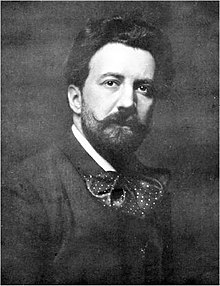
Portrait by Ernest Walter Histed, c. 1906
Sir Henry Joseph Wood CH (3 March 1869 – 19 August 1944) was an English conductor best known for his association with London's annual series of promenade concerts, known as the Proms. He conducted them for nearly half a century, introducing hundreds of new works to British audiences. After his death, the concerts were officially renamed in his honour as the "Henry Wood Promenade Concerts", although they continued to be generally referred to as "the Proms".
Born in modest circumstances to parents who encouraged his musical talent, Wood started his career as an organist. During his studies at the Royal Academy of Music, he came under the influence of the voice teacher Manuel García and became his accompanist. After similar work for Richard D'Oyly Carte's opera companies on the works of Arthur Sullivan and others, Wood became the conductor of a small operatic touring company. He was soon engaged by the larger Carl Rosa Opera Company. One notable event in his operatic career was conducting the British premiere of Tchaikovsky's Eugene Onegin in 1892. (Full article...) -
Image 10Swift at the 2023 MTV Video Music Awards
Taylor Alison Swift (born December 13, 1989) is an American singer-songwriter. A subject of widespread public interest with a vast fanbase, she has influenced the music industry, popular culture, and politics through her songwriting, artistry, and advocacy.
Swift began professional songwriting at 14. She signed with Big Machine Records in 2005 and achieved prominence as a country pop singer with the albums Taylor Swift (2006) and Fearless (2008). Their singles "Teardrops on My Guitar", "Love Story", and "You Belong with Me" were crossover successes on country and pop radio formats and brought Swift mainstream fame. She experimented with rock on Speak Now (2010) and electronic styles on Red (2012); the latter featured her first Billboard Hot 100 number-one single, "We Are Never Ever Getting Back Together". Swift recalibrated her image from country to pop with 1989 (2014), a synth-pop album containing the chart-topping songs "Shake It Off", "Blank Space", and "Bad Blood". Media scrutiny inspired the hip-hop-influenced Reputation (2017) and its number-one single "Look What You Made Me Do". (Full article...) -
Image 11The Concert in Central Park is the first live album by American folk rock duo Simon & Garfunkel, released on February 16, 1982, by Warner Bros. Records. It was recorded on September 19, 1981, at a free benefit concert on the Great Lawn in Central Park, New York City, where the pair performed in front of 500,000 people. A film of the event was shown on TV and released on video. Proceeds went toward the redevelopment and maintenance of the park, which had deteriorated due to lack of municipal funding. The concert and album marked the start of a three-year reunion of Paul Simon and Art Garfunkel.
The concept of a benefit concert in Central Park had been proposed by Parks Commissioner Gordon Davis and promoter Ron Delsener. Television channel HBO agreed to carry the concert, and they worked with Delsener to decide on Simon and Garfunkel as the appropriate act for this event. Besides hits from their years as a duo, their 21-song set list included material from their solo careers, and covers. Amongst them were "The Sound of Silence", "Mrs. Robinson", "The Boxer" and Simon's "Late in the Evening", with the show concluding with a reprise of the latter. Ongoing personal tensions between the duo led them to decide against a permanent reunion, despite the success of the concert and a subsequent world tour. (Full article...) -
Image 12The Basement Tapes is the sixteenth album by the American singer-songwriter Bob Dylan and his second with the Band. It was released on June 26, 1975, by Columbia Records. Two-thirds of the album's 24 tracks feature Dylan on lead vocals backed by the Band, and were recorded in 1967, eight years before the album's release, in the lapse between the release of Blonde on Blonde and the subsequent recording and release of John Wesley Harding, during sessions that began at Dylan's house in Woodstock, New York, then moved to the basement of Big Pink. While most of these had appeared on bootleg albums, The Basement Tapes marked their first official release. The remaining eight songs, all previously unavailable, feature the Band without Dylan and were recorded between 1967 and 1975.
During his 1965–1966 world tour, Dylan was backed by the Hawks, a five-member rock group who would later become famous as the Band. After Dylan was injured in a motorcycle accident in July 1966, four members of the Hawks came to Dylan's home in the Woodstock area to collaborate with him on music and film projects. While Dylan was out of the public's eye during an extended period of recovery in 1967, he and the members of the Hawks recorded more than 100 tracks together, incorporating original compositions, contemporary covers, and traditional material. Dylan's new style of writing moved away from the urban sensibility and extended narratives that had characterized his most recent albums, Highway 61 Revisited and Blonde on Blonde, toward songs that were more intimate and which drew on many styles of traditional American music. While some of the basement songs are humorous, others dwell on nothingness, betrayal and a quest for salvation. In general, they possess a rootsy quality anticipating the Americana genre. For some critics, the songs on The Basement Tapes, which circulated widely in unofficial form, mounted a major stylistic challenge to rock music in the late sixties. (Full article...) -
Image 13Surfer Rosa is the debut studio album by the American alternative rock band Pixies, released in March 1988 on the British label 4AD. It was produced by Steve Albini. Surfer Rosa contains many of the elements of Pixies' earlier output, including Spanish lyrics and references to Puerto Rico. It includes references to mutilation and voyeurism alongside experimental recording techniques and a distinctive drum sound.
As 4AD was an independent label, distribution in the United States was handled by British label Rough Trade Records; however, it failed to chart in either country. Only one single was released, a rerecorded version of "Gigantic", and reached number 93 on the UK Singles Chart. Surfer Rosa was rereleased in the US by Elektra Records in 1992, and in 2005 was certified gold by the Recording Industry Association of America. (Full article...) -
Image 14

Percy Aldridge Grainger (born George Percy Grainger; 8 July 1882 – 20 February 1961) was an Australian-born composer, arranger and pianist who moved to the United States in 1914 and became an American citizen in 1918. In the course of a long and innovative career he played a prominent role in the revival of interest in British folk music in the early years of the 20th century. Although much of his work was experimental and unusual, the piece with which he is most generally associated is his piano arrangement of the folk-dance tune "Country Gardens".
Grainger left Australia at the age of 13 to attend the Hoch Conservatory in Frankfurt. Between 1901 and 1914 he was based in London, where he established himself first as a society pianist and later as a concert performer, composer, and collector of original folk melodies. As his reputation grew he met many of the significant figures in European music, forming important friendships with Frederick Delius and Edvard Grieg. He became a champion of Nordic music and culture, his enthusiasm for which he often expressed in private letters, sometimes in crudely racial or anti-Semitic terms. (Full article...) -
Image 15

Cover of the anonymous play, The True Tragedy of Richard III (1594), which was "to be sold by William Barley, at his shop in Newgate Market"
William Barley (1565?–1614) was an English bookseller and publisher. He completed an apprenticeship as a draper in 1587, but was soon working in the London book trade. As a freeman of the Drapers' Company, he was embroiled in a dispute between it and the Stationers' Company over the rights of drapers to function as publishers and booksellers. He found himself in legal tangles throughout his life.
Barley's role in Elizabethan music publishing has proved to be a contentious issue among scholars. The assessments of him range from "a man of energy, determination, and ambition", to "somewhat remarkable", to "surely to some extent a rather nefarious figure". His contemporaries harshly criticised the quality of two of the first works of music that he published, but he was also influential in his field. (Full article...)
Selected pictures
-
Image 1Photograph: Stefan KrauseHenrik Freischlader (b. 1982) is a German blues guitarist and singer. He began his career in 1998, and established his own label, Cable Car Records, in 2009.
-
Image 2Photograph credit: William P. Gottlieb; restored by Adam CuerdenThelonious Monk (October 10, 1917 – February 17, 1982) was an American jazz pianist and composer, and the second-most-recorded jazz composer after Duke Ellington. He had a unique improvisational style and famously remarked, "The piano ain't got no wrong notes". He made numerous contributions to the standard jazz repertoire, including "'Round Midnight", and a wide range of other compositions. He was renowned for a distinctive dress style, which included suits, hats, and sunglasses. He had disappeared from the scene by the mid-1970s and made only a few appearances during the final decade of his life. This 1947 photograph of Monk was taken by the American photographer William P. Gottlieb in Minton's Playhouse, a jazz club in New York.
-
Image 3Manuscript: Alessandro ScarlattiGriselda is an opera seria in three acts by the Italian composer Alessandro Scarlatti. First performed in 1721, it is based on the story of Patient Griselda from Giovanni Boccaccio's Decameron. The libretto is by Apostolo Zeno, with revisions by an anonymous author. This manuscript copy by Scarlatti, held at the British Library, is of act one, scene one.
-
Image 4Photograph credit: Carl Van Vechten; restored by Adam CuerdenBessie Smith (April 15, 1894 – September 26, 1937) was an American blues singer widely renowned during the Jazz Age. She is often regarded as one of the greatest singers of her era and was a major influence on fellow blues singers, as well as jazz vocalists.
Born in Chattanooga, Tennessee, her parents died when Smith was young, and she and her sister survived by performing on the streets of Chattanooga, Tennessee. She began touring and performed in a group that included Ma Rainey, and then went out on her own. Her successful recording career began in the 1920s, until an automobile accident ended her life at age 43. -
Image 5Photo: Teemu RajalaVexi Salmi is a popular Finnish lyricist who has become popular through the successes of the platinum-selling music artists for whom he writes. During his prolific career, he has written the lyrics for over 4,000 songs, more than 2,400 of which have been recorded by prominent artists such as Irwin Goodman, Jari Sillanpää, and Katri Helena. A music writer's award, the Vexi Salmi Award, is named after him.
-
Image 6Photo: W. J. Mayer; Restoration: Lise BroerA bust of the German composer and pianist Ludwig van Beethoven (1770–1827), made from his death mask. He was a crucial figure in the transitional period between the Classical and Romantic eras in Western classical music, and remains one of the most acclaimed and influential composers of all time. Born in Bonn, of the Electorate of Cologne and a part of the Holy Roman Empire of the German Nation in present-day Germany, he moved to Vienna in his early twenties and settled there, studying with Joseph Haydn and quickly gaining a reputation as a virtuoso pianist. His hearing began to deteriorate in the late 1790s, yet he continued to compose, conduct, and perform, even after becoming completely deaf.
-
Image 7Painting credit: Anthony van DyckNicholas Lanier (baptised 10 September 1588 – buried 24 February 1666) was an English composer and musician; the first to hold the title of Master of the King's Music, in the service of Charles I and Charles II. He was one of the first composers to introduce monody and recitative to England.
After this oil-on-canvas portrait was painted by the Flemish painter Anthony van Dyck in Antwerp, Lanier convinced the king to bring van Dyck to England, where he became the leading court painter. The portrait displays an attitude of studied carelessness, often termed sprezzatura, defined as "a certain nonchalance, so as to conceal all art and make whatever one does or says appear to be without effort and almost without any thought about it". The painting now hangs in the Kunsthistorisches Museum in Vienna. -
Image 8Photograph credit: Eugène Pirou; restored by Adam CuerdenJules Massenet (12 May 1842 – 13 August 1912) was a French composer of the Romantic era, best known for his operas. Between 1867 and his death, he wrote more than forty stage works in a wide variety of styles, from opéra comique to grand depictions of classical myths, romantic comedies and lyric dramas, as well as oratorios, cantatas and ballets. Massenet had a good sense of the theatre and of what would succeed with the Parisian public. Despite some miscalculations, he produced a series of successes that made him the leading opera composer in France in the late 19th and early 20th centuries. By the time of his death, he was regarded as old-fashioned; his works, however, began to be favourably reassessed during the mid-20th century, and many have since been staged and recorded. This photograph of Massenet was taken by French photographer Eugène Pirou in 1875.
-
Image 9Alexz Johnson (b. 1986) is a Canadian singer-songwriter and actress, best known for roles as Jude Harrison in the CTV series Instant Star (character shown here), Annie Thelan in the Disney Channel series So Weird, and as Erin Ulmer in the 2006 horror film Final Destination 3. Her album Voodoo was released in 2010.
-
Image 10Photograph credit: Jean Reutlinger; restored by Adam CuerdenNelly Martyl (1884–1953) was a French opera singer. She sang in the premieres of several operas, including Leborne's La Catalane (1907), Erlanger's La Sorcière (1912), and Massenet's Amadis (1922). Martyl joined the Red Cross as a nurse during the First World War, and served at the Battle of Verdun in 1916, where she was known as la fée de Verdun (the Fairy of Verdun), and at the Second Battle of the Aisne in 1917. She continued as a nurse after the war to help with the 1918 epidemic of Spanish flu. She was awarded the Croix de Guerre with the carte du combattant (signifying service under particular hazard) in 1920.
-
Image 11Photo: Benoît Derrier; edit: KeraunoscopiaAne Brun (b. 1976) is a Norwegian songwriter, guitarist and vocalist. She has recorded eight albums, starting in 2003 with Spending Time with Morgan.
-
Image 12Photograph: Sven-Sebastian SajakMike Dirnt (b. 1972) is an American musician, songwriter and composer. He is best known as the co-founder, bassist, backing and occasional lead vocalist of American punk rock band Green Day. He has played in several other bands, including The Frustrators.
-
Image 13Elvis Presley meets Richard NixonPhotograph: Oliver F. AtkinsAmerican singer Elvis Presley meeting then-president Richard Nixon on December 21, 1970. During the meeting, the singer expressed his patriotism and his contempt for hippies, the growing drug culture, and the counterculture in general. Presley then asked Nixon for a Bureau of Narcotics and Dangerous Drugs badge, to signify official sanction of his patriotic efforts. Nixon gave Presley the badge and expressed a belief that Presley could send a positive message to young people and that it was therefore important he retain his credibility.
-
Image 14Photo: ChrisHamburgOceana (born 1982) is a German singer of German/Martiniquen descent. She is shown here performing at the Radio Hamburg Top 820.
-
Image 15Graphic: Giuseppe PalantiMédée is a French-language opera by the composer Luigi Cherubini. Set in the ancient city of Corinth, Greece, it features a libretto by François-Benoît Hoffman and is based on Euripides's tragic play Medea and Pierre Corneille's play Médée. The opera premiered in 1797 at the Théâtre Feydeau in Paris. The long-lost final aria, which Cherubini appears to have deleted from his original manuscript, was discovered by researchers from the University of Manchester and Stanford University by employing X-ray techniques to reveal areas that the composer had blackened out.
This picture shows the title page for a vocal score of the 1909 hybrid version of Médée.
Related portals
Did you know (auto-generated)

- ... that Wilner Burke was the director of the Lumberjack Band, the marching band of the Green Bay Packers, for 42 years?
- ... that Oksana Lyniv founded the Youth Symphony Orchestra of Ukraine in 2016 and conducted them in thirty concerts across ten music festivals in 2022?
- ... that the Soviet soprano Tamara Milashkina performed alongside her husband Vladimir Atlantov at New York's Metropolitan Opera in 1975?
- ... that Max Weil, founder of the Halifax Symphony Orchestra, spent his later years in real estate?
- ... that a will bequeathing the Chestnut Street Opera House to the University of Pennsylvania was contested at the Supreme Court of Pennsylvania?
- ... that Felipe Lara's Pulitzer finalist Double Concerto turns its soloists into a "many-tentacled creature"?
Today's Birthdays
- Birthdays in Music: July 3
- Betty Buckley, American musical theatre actress, turns 77.
- Mick Hanly, Irish singer & songwriter, turns 75.
- Michael Corby, Brit keyboardist and guitarist for The Babys, turns 69.
- Stephen Pearcy, American singer with Ratt, turns 68.
- Vince Clarke, Brit songwriter with Depeche Mode, Erasure, and The Assembly, turns 64.
- Kevin Hearn, Canadian keyboardist for Barenaked Ladies, turns 55.
- Shane Lynch, Irish mime artist and boy band vocalist of Boyzone fame, turns 48.
Categories

Explore
Connections
WikiProjects connected with music: WikiProject Music – Songs – Albums – Alternative music - Classical music – Composers – Contemporary Christian music – Contemporary music – Electronic music – Emo music – Hip hop – Instruments – Led Zeppelin - Metal music – Jazz – Musicians – Opera – Panic at the Disco – Powderfinger (band) – Punk music – Record Labels – Record Production – Rock music – R&B and Soul Music – Terminology – The Beatles
Create a requested article: See the list of Requested articles.
Improve an article: See the Music Noticeboard for a list of tasks.
Start a music course: School of Music at Wikiversity
Associated Wikimedia
The following Wikimedia Foundation sister projects provide more on this subject:
-
Commons
Free media repository -
Wikibooks
Free textbooks and manuals -
Wikidata
Free knowledge base -
Wikinews
Free-content news -
Wikiquote
Collection of quotations -
Wikisource
Free-content library -
Wikispecies
Directory of species -
Wikiversity
Free learning tools -
Wikivoyage
Free travel guide -
Wiktionary
Dictionary and thesaurus
Text is available under the Creative Commons Attribution-ShareAlike License. Additional terms may apply.
↑




